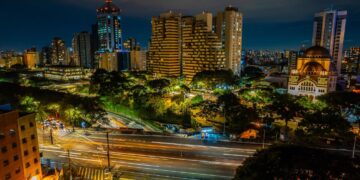Introduction
In recent years, Brazilian cities have faced a dual crisis: rapid urbanization and the increasing severity of climate change-related flooding.As communities adapt to these challenges, some municipalities have turned to a controversial solution—hiding their rivers underground. While this practice was initially thought to facilitate progress and mitigate flooding, the unintended consequences have become alarmingly clear.As heavy rains inundate streets and overwhelm drainage systems, residents find themselves grappling with the repercussions of concealing vital waterways. This article explores the complexities of Brazil’s urban waterways, examining the environmental, social, and economic impacts as cities contend with the floods they sought to avert. From São Paulo to Rio de Janeiro, the call for a reevaluation of urban planning practices has never been more urgent.
Cities Face Flooding Crisis as Underground Rivers Emerge in Brazil
In recent years, cities across Brazil have been grappling with unprecedented flooding, directly linked to the decision to conceal rivers beneath urban landscapes. These underground rivers, once integral to the natural drainage systems, have become increasingly overwhelmed due to urban sprawl and climate change. As heavy rains saturate the ground, the hidden waterways overflow, leading to disastrous consequences. The flooding impacts not only the environment but also the livelihoods of thousands as homes and businesses face the brink of inundation.
Many experts argue that the urban planning policies that prioritized development over natural waterways have exacerbated the crisis. Efforts are being made to restore the rivers and incorporate sustainable drainage solutions. Key strategies being discussed include:
- Daylighting Rivers: Bringing concealed rivers back to the surface to improve natural flow and reduce flood risk.
- Green Infrastructure: Implementing parks and gardens to absorb rainwater and create recreational spaces.
- Community engagement: Involving local populations in urban planning processes to ensure sustainable development.
Local governments are now faced with the challenge of transforming their approaches to urban planning to prioritize ecological stability. The following table highlights some of the key cities affected by flooding and their corresponding measures to mitigate the emerging crisis:
| City | Flooding Severity | Mitigation Measures |
|---|---|---|
| São Paulo | High | Daylighting Project Initiatives |
| Rio de Janeiro | Medium | Green Roof Development |
| Belo Horizonte | High | Community Flood Awareness programs |
Urban Planning Failures Contribute to Environmental Catastrophe
The decision to conceal rivers beneath concrete and asphalt in urban areas has frequently enough seemed like a practical solution to manage city expansion and mitigate flooding risks. However, this approach has drastically backfired, creating serious repercussions for both the environment and local communities. As heavy rains pummel cities like São Paulo and rio de Janeiro, the repercussions of burying rivers become painfully clear, leading to dramatic flooding that overwhelms drainage systems. The consequences are felt most acutely in the poorest neighborhoods, where infrastructure is inadequate and emergency response can be slow or ineffective.
In evaluating the impact of these urban planning decisions, it is indeed crucial to consider several key factors contributing to the environmental crisis. These include:
- Loss of Biodiversity: Concealed waterways no longer support natural habitats, leading to reduced flora and fauna.
- Increased Surface Runoff: Without permeable ground, rainwater cannot infiltrate the soil, leading to higher runoff rates and exacerbating flooding.
- pollution Concentration: Hidden rivers can act as flood conduits for pollutants,endangering both water quality and public health.
- Climate Resilience: cities become less adaptable to climate change, increasing vulnerability to extreme weather events.
These urban planning missteps have led to more than just infrastructural failures; they have redefined the relationship between cities,their environments,and their inhabitants. A shift in strategy is imperative, one that prioritizes ecological integrity and acknowledges natural water systems as vital components of urban planning rather than obstacles to development.
Strategies for Sustainable water Management and River Restoration in Brazilian Cities
Effective water management and river restoration in Brazilian cities call for a multifaceted approach that emphasizes the integration of natural systems into urban planning. Green infrastructure solutions, such as the creation of urban wetlands and rain gardens, can significantly reduce stormwater runoff by allowing water to infiltrate the ground naturally. Cities should consider the following strategies:
- Restoration of Natural Riverbanks: Enhancing the ecological resilience of rivers by reintroducing native vegetation to restore habitats.
- Daylighting Rivers: Uncovering buried rivers to reintegrate them into the urban landscape,increasing accessibility and enhancing biodiversity.
- Community Engagement: Involving local communities in restoration projects to foster a sense of ownership and awareness about sustainable practices.
- Innovative Stormwater Management: Implementing systems like permeable pavements and storage basins to manage and reduce flooding risk.
As Brazilian cities face increasing challenges from urban flooding, prioritizing sustainable practices is essential for long-term resilience. A collaborative effort among government agencies, environmental organizations, and local communities can drive these initiatives forward. The implementation of smart water management technologies and the establishment of regulatory frameworks ensuring the protection and restoration of urban waterways are critical components that can facilitate ongoing improvements. Table data can showcase the expected benefits of various restoration projects:
| strategy | Expected Benefits |
|---|---|
| Restoration of natural Riverbanks | Enhances biodiversity and water quality |
| Daylighting Rivers | Increases public space and mitigates flooding |
| Green roofs | Reduces urban heat and stormwater runoff |
| Community Engagement | Builds awareness and fosters stewardship |
Concluding Remarks
As cities across Brazil grapple with the devastating consequences of increasingly frequent floods, the decision to conceal rivers beneath urban landscapes is coming under intense scrutiny. The conversion of these natural waterways into underground channels—once viewed as a solution to urbanization challenges—has instead exacerbated flooding risks and strained infrastructure. experts emphasize the urgent need for a reevaluation of urban planning policies, advocating for a more sustainable approach that acknowledges the importance of maintaining and restoring river ecosystems. As the nation faces the reality of climate change and rapid population growth, a coordinated effort between government officials, environmentalists, and communities is essential to ensure that the lessons learned from recent flooding are not overlooked.Only by reimagining the relationship between cities and their waterways can Brazil hope to mitigate future disasters and safeguard the well-being of its citizens.







![[Expired] [Award Alert] U.S. Cities to São Paulo, Brazil From 50K Miles in Business Class – Upgraded Points](https://capital-cities.info/wp-content/uploads/2025/07/149760-expired-award-alert-us-cities-to-sao-paulo-brazil-from-50k-miles-in-business-class-upgraded-points-360x180.jpg)







